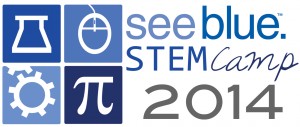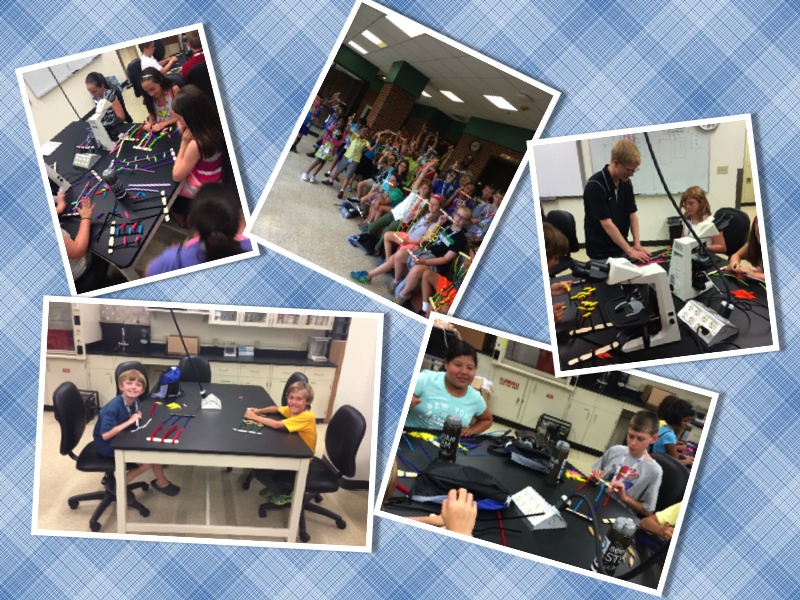 After the longest school year in a while and some other area camps, it is finally time for the 2014 See Blue STEM Camp! We are so excited to have 144 campers this year…together…at the same time…in the same week (Craig and I may be greyer by the end of the week 🙂 )! Registration went very smooth this morning and we appreciate everyone’s patience in getting all the forms turned in, etc. You all rock!
After the longest school year in a while and some other area camps, it is finally time for the 2014 See Blue STEM Camp! We are so excited to have 144 campers this year…together…at the same time…in the same week (Craig and I may be greyer by the end of the week 🙂 )! Registration went very smooth this morning and we appreciate everyone’s patience in getting all the forms turned in, etc. You all rock!
We will post a blog post each night with some highlights from the day and some conversation starters. We’ll also post a link to the photos we are taking throughout the week.
Today the blue and red groups (rising 5-6th graders) headed to Dr. Robin Cooper’s (Dept of Biology) laboratory to do some neurobiology experiments today. They got to use iPads (Backyard Brains app – it’s free!) to collect data about muscle movements. Additionally they built some structures out of pipe cleaners that you should ask them about. Most of them fit in their sack packs and so you should be able to have them talk to you about it.
The yellow and green groups (rising 7th-8th graders) got to experience different aspects of nanotechnology with Dr. Brett Criswell from the Dept of STEM Education. They conducted several mini-experiments and were pretty wowed over by many of them! He was a definite favorite amongst the students today…hopefully the rest of the presenters live up to the high bar he has set today!
In robotics, both groups started by reverse engineering their robots. They were given a fully assembled robot and they had to disassemble it and re-assemble it. They always love this part, but we’re eager to continue moving them on to basic programming challenges. This year, the red and blue groups will be working with the NXT robots and the Green City Challenge. The yellow and green groups will be working with the EV3 robots and the newly-released Space Challenge. The yellow and green groups got a glimpse at the new programming software today and so that was pretty exciting for them.
We got so excited about watching the kids robots take shape that we forgot to snap some robotics pictures! We promise to do better tomorrow.
Your kids will be working in groups all week long. The robotics groups are teams of 2 and will stay the same all week long, while the other groups formed will vary throughout the week. As the “real world” continues to become more team-work oriented, we want to help our students grow in that direction as well. We hope your child gets to work with a variety of students this week and in turn meets some great new friends!
In their words… – Each day we’ll post some excerpts from the students’ reflections of what they learned each day at the content session.
What I learned today…
-
Muscles contract and relax. When you get a muscle disease your muscles start to slow down and your heart stops and you can’t breathe. People who get it have to wear masks to breathe for them. I learned that you can record electrical activity from insects. (red/blue group)
-
I learned about how muscles work. That energy comes from your body. You could record energy going through your muscles. I did not know anything about muscles, but now I know about myosins. (red/blue group)
-
I found out that calcium chlorine and antacid make orbs. I learned that things that absorb water don’t absorb oil or vice versa. You can make magic sand water proof. I learned more about chemicals and chemical reactions. (green/yellow group)
-
Plants have waxy leaves to self clean. Peaches reflect water because of the peach fuzz. I learned about the practical uses of nanotechnology in everyday life, particularly when it comes to manipulating liquids. I learned that some materials repel water molecules. Nanotechnology and how it’s a world too small for the naked human eye to see. (green/yellow group)
What did you like about what you learned today…
-
My muscles conduct electricity. Seeing electricity in my arm with the iPad. It was awesome! Everything! I learned a lot and i really enjoyed it! The myosin heads and how they work. (red/blue group)
-
It is really cool to know college/high school level stuff. I liked testing my biceps with the meter. That muscles have electrical activity. (red/blue group)
-
It was interesting and fun. I liked being able to use my hands in everything. I actually enjoyed everything. I enjoyed how it was hands on and not just sitting and listening. (yellow/green group)
-
The magic sand repelled water. Everything, but the fabric and with special fibers was my favorite. I liked that we actually got to experiment. The experiments were cool and hands on. What i liked about nanotechnology was when the spheres expanded and when we took them out. i liked everything we did. I liked playing with the “magic” green sand. I thought it was very cool the way it worked. (yellow/green group)
Conversation Starters…– We know that your child is getting to the age where it might be like pulling teeth to get them to talk about their day beyond “It was fine.” “It was fun.” Each day we’ll post some suggested conversation starters centered on camp activities or STEM-related themes.
Red/Blue Groups (rising 5-6th graders):
- I didn’t realize my body could conduct electricity…tell me more about that!
- What was the pipe cleaner structure that you built? Tell me more about it.
- What kind of tests did you conduct on your muscles? What were you testing? What were you looking for?
Yellow/Green Groups (rising 7-8th graders):
- What is nanotechnology?
- What kinds of things repel water? Why do they need to repel water?
- How do you make magic sand?
- Peaches reflect water? I’ve never heard about that. Tell me more!
Photo of the Day… – Each day we’ll post a photo collage highlight. Clicking on the picture will also link to all of the pictures taken at camp. Please note that we try to capture pictures of all of the campers, but we cannot guarantee that we will get every single one. We try our very best too! Also, we are STEM teachers and not full time photographers, so our pictures are not perfect and we leave them unedited, so if you love to edit photos…feel free! (We did not do very well with posting to Twitter and taking photos today, but we promise to do better tomorrow!)


